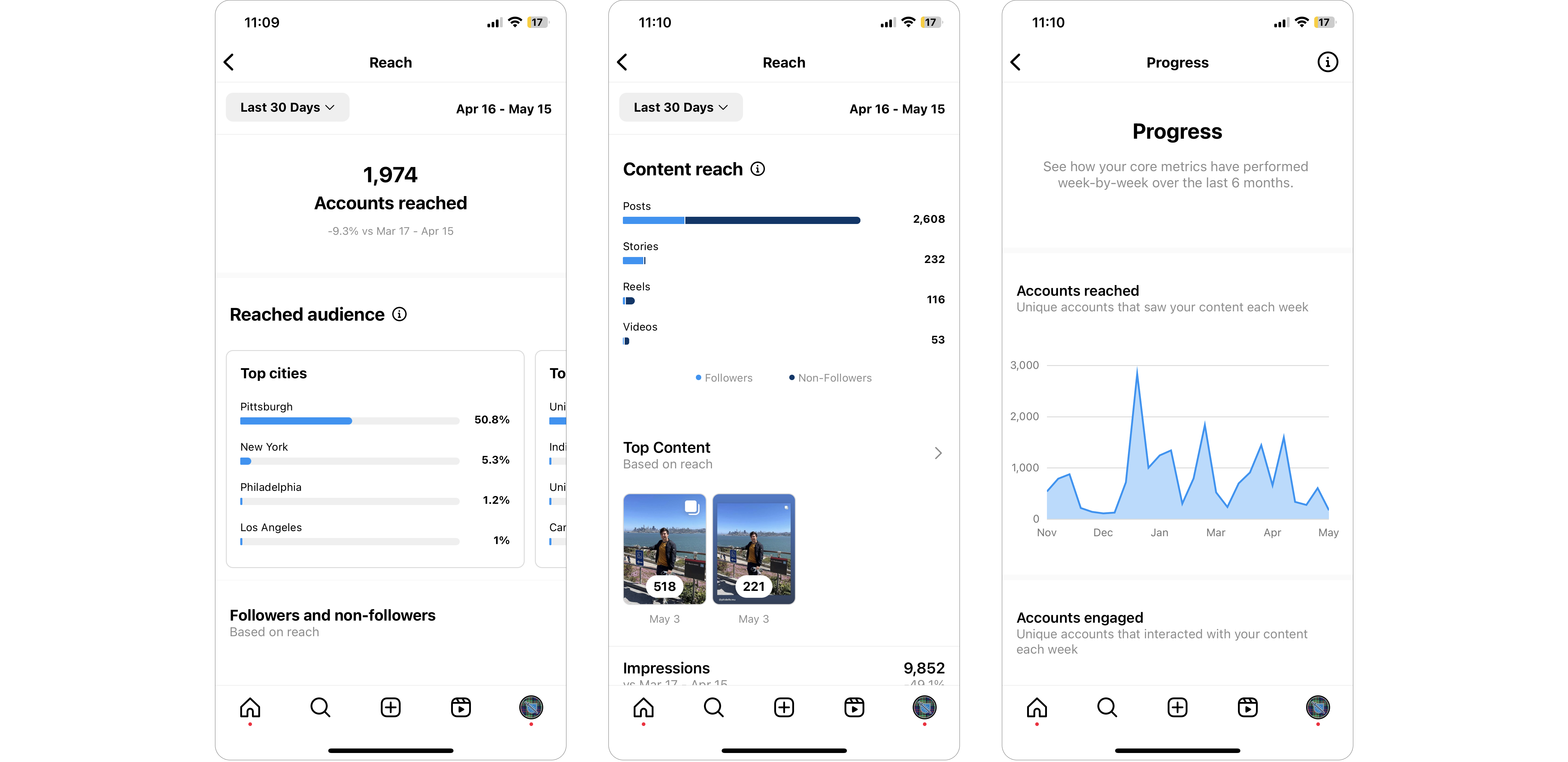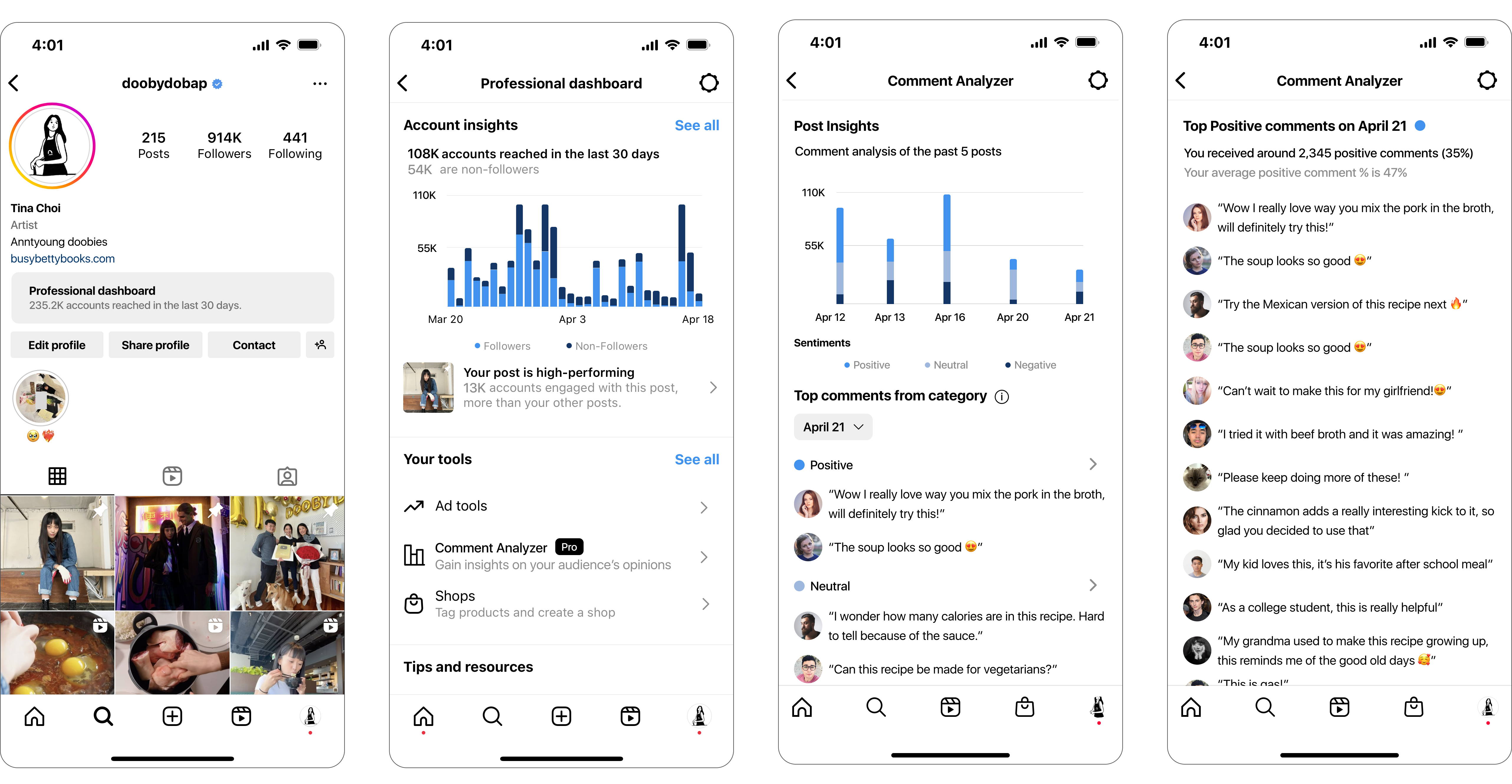AI-powered Instagram comment analyzer for influencers
This Instagram tool uses Natural Language Processing (NLP) to provide Instagram influencers the ability to recognize the type of content that is successful within their followers and figure out how to tailor their content to best fit their audience and keep them engaged, resulting in greater reach.
The goal of this project was to understand how an AI tool can help a product like Instagram. We prototyped the tool and outlined how it is technically and financially feasible for Instagram to implement.
Role: UX design, Visual design, Business Research
Collaborators: Shubham, Tara, Roong, Chloe, Xinhang
Duration: 2 weeks
Tools: Figma

Comments are a great dataset to add precision and value to content but due to high volume, Instagram influencers are unable to read all comments in a single post.
Influencers’ posts receive thousands of comments, some of which contain information which can provide valuable insight into how to improve their content to better fit their audience.
For example, the Instagram post below shows how comments can reveal valuable information about why this influencer’s post was particulary successful, allowing them to tailor their content accordingly.

RESEARCH QUESTION
How might we help Instagram influencers understand what type of content works best for their target audience?
CURRENT SOLUTION
Instagram offers a tool which analyzes audience engagement free of charge. This tools tracks each post’s public reach. Although this is helpful for influencers, these reports only consist of quantitative analysis, making it difficult for users to extract useful qualitative insights.
Here is an example of the quantitative analysis available to influencers:
Here is an example of the quantitative analysis available to influencers:

INSTAGRAM COMMENT ANALYZER - WORKINGS AND FLOW
With this solution, influencers will have a breakdown of the comments they receive into three categories: positive, neutral, and negative, so they can see why certain posts were more successful than the others. I worked with Instagram’s pre-exisiting visual design system to prototype the screens to demonstrate the user flow of this tool.
Our new tool categorizes comments on an Instagram post using NLP’s ability of sentiment analysis.
With this solution, influencers will have a breakdown of the comments they receive into three categories: positive, neutral, and negative, so they can see why certain posts were more successful than the others. I worked with Instagram’s pre-exisiting visual design system to prototype the screens to demonstrate the user flow of this tool.
Profile page
Users navigate to the profile page and they click on the ‘professional dashboard’ button.
Users navigate to the profile page and they click on the ‘professional dashboard’ button.
Professional dashboard
Users browse through the different data analysis tools and click on the ‘Comment Analyzer’ with the ‘Pro’ tag next to it since it is a subscription based feature.
Users browse through the different data analysis tools and click on the ‘Comment Analyzer’ with the ‘Pro’ tag next to it since it is a subscription based feature.
Comment Analyzer
Users can choose the post for which they want to look at the sentiment analysis data for. They can then choose a particular sentiment they want to see further.
Users can choose the post for which they want to look at the sentiment analysis data for. They can then choose a particular sentiment they want to see further.
Comments breakdown
Users can browse through comments that make up their chosen sentiment category to understand what works and what doesn’t.
Users can browse through comments that make up their chosen sentiment category to understand what works and what doesn’t.

FINANCIAL VIABILITY
Instagram takes 45% of the revenue generated from ads posted by influencers.
With this product, influencers will have a higher audience reach, which will attract more advertisers to this platform and in turn generate increased revenue for Instagram. The diagram below highlights how this product fits within Instagram’s business model:

Another stream of income for Instagram will be through the subscription fees that comes with our service. Below are some currently available third party analytics on the market. We are going to be competitive with our pricing, while offering more. The pricing is monthly and tier-based, and the first tier is free to attract more influencers.

Instagram influencers currently have a market of $60B+ with 80M+ influencers. We can make monthly revenue of around $40M (assuming influencers opt in for Tier 2 pricing) to innovate, maintain, and improve our product assuming 1% conversion rate.
TECHNICAL FEASIBILITY
Automated sentiment scoring accuracy can easily reach or exceed the 80-85% human agreement baseline.
This product is technically feasible because it is accurate and low-cost. Research suggests that a sentiment model with approximately 80% accuracy is "good enough" for human readers when compared to the original text-to-model outputs.
The technical workings of this product is shown below.

POTENTIAL RISKS
- Bias - training data can be polarizing and unfiltered.
- Transparency - lack of model explainability can lead to confirmation bias.
REFLECTION
How did I feel when working on this project?
I felt excited working on a project with such a broad and real life scope. I was overwhelmed at the beginning during the brainstorming stage because thinking about an idea from a technical and a financial standpoint was something I did not have a lot of experience with so ideating was a little challenging but I learnt a lot from it. I am proud of what we were able to achieve in a short span of time in an area that is very new and rapidly developing.
I learned that I get distracted quite quickly, and I am thankful that my teammates were there to keep me on task. Among other things, I’ve learned to ask questions rigorously and constantly assess my approach towards solving the problem.
I would have spent more time reflecting on how to represent such a big data-set to the audience in a more cohesive and more importantly, a more informative manner. Yes, the influencer can tell which comments are positive, neutral and negative, but can I use design to tell them about why we chose to categorize a particular comment in a particular category? This question is a whole project within itself but it is definitely something I would like to think about more.
I'm very thankful that our team was incredibly hardworking, insightful, and organized. Also, I learned that working with AI majors (Tara and Chloe) on a product is very different compared to working with other designers. It was so interesting to learn how they think about a product verses how I would approach a product. Being able to bounce around design ideas and engage in design debates with my very non-designer group was a lot of fun!
How did I feel when working on this project?
I felt excited working on a project with such a broad and real life scope. I was overwhelmed at the beginning during the brainstorming stage because thinking about an idea from a technical and a financial standpoint was something I did not have a lot of experience with so ideating was a little challenging but I learnt a lot from it. I am proud of what we were able to achieve in a short span of time in an area that is very new and rapidly developing.
What did I learn about myself from this project?
I learned that I get distracted quite quickly, and I am thankful that my teammates were there to keep me on task. Among other things, I’ve learned to ask questions rigorously and constantly assess my approach towards solving the problem.
What would I have done differently in hindsight?
I would have spent more time reflecting on how to represent such a big data-set to the audience in a more cohesive and more importantly, a more informative manner. Yes, the influencer can tell which comments are positive, neutral and negative, but can I use design to tell them about why we chose to categorize a particular comment in a particular category? This question is a whole project within itself but it is definitely something I would like to think about more.
What did I learn about my team-mates from this project?
I'm very thankful that our team was incredibly hardworking, insightful, and organized. Also, I learned that working with AI majors (Tara and Chloe) on a product is very different compared to working with other designers. It was so interesting to learn how they think about a product verses how I would approach a product. Being able to bounce around design ideas and engage in design debates with my very non-designer group was a lot of fun!